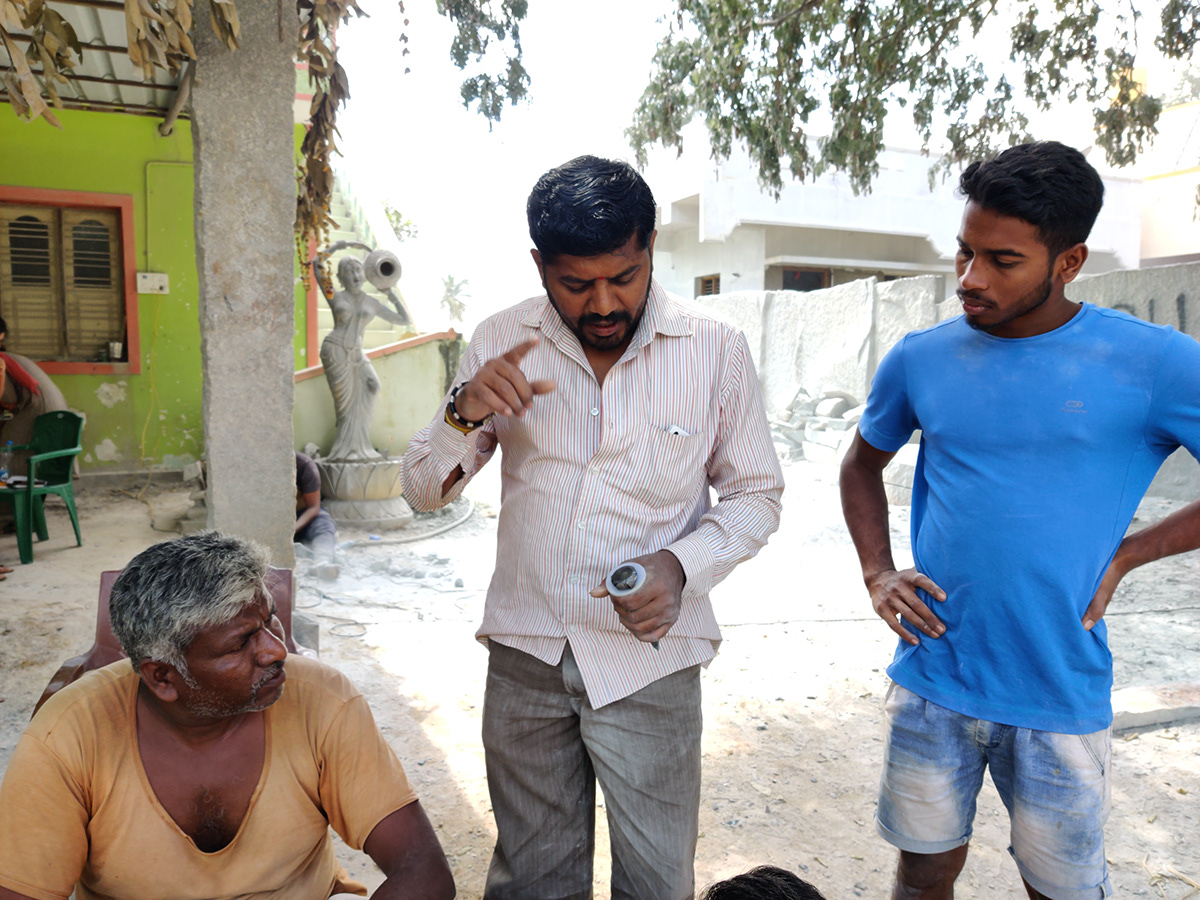


01. Empathize
Based on the observations, the artisans showed a clear challenge of poor ergonomics at the work place and possibility of musculoskeletal disorders in the artisans. Images below indicate awkward postures, forceful gripping, repetitive action of arms while hammering the chisels.
1.1. Gaps & Challenges Identified
The Ethnographic study shows the following challenges of the stone craft artisan community :
1- Unsafe and Unorganized workplace,
it lead to reduced productivity and efficiency.
recurrent fatigue and stress (physiological, financial and phycological).
2- Unsustainable material used by the artisan to store the craft tools.
Lack of enthusiasm in the artisan community to sustain the craft due to prolonged health and safety
challenges in the craft.
1- Unsafe and Unorganized workplace,
it lead to reduced productivity and efficiency.
recurrent fatigue and stress (physiological, financial and phycological).
2- Unsustainable material used by the artisan to store the craft tools.
Lack of enthusiasm in the artisan community to sustain the craft due to prolonged health and safety
challenges in the craft.
As shown in figure below, the musculoskeletal disorders in the artisans in arm/ wrist, and lower back are very prominent.




02. Define
To redesign a protective gear for better handling of chisel by reducing the impact of hammer on the arms of artisans.






2.1. Data collection and Analysis
Observations of artisans in their work space were made through ethnographic research approach, with regards to ergonomics. Out of around 100 artisans, 30 artisans were interviewed using Nordic Questionnaire on musculoskeletal disorders.

Refering to the graph below, the number of artisans with pain since 12 months, number of artisans who couldn’t work because of the pain, and the number of artisans with pain since a week.
It is evident from the graph that number of artisans with wrist/ arm pain since 12 months is highest followed by lower back pain. Also, number of artisans who could not work because of the wrist/ arm pain is highest among all other areas. This gave a clear insight regarding the most prevalent MSD in their arms.

3. Prototype
Concept design 1
In this design, a silicone rubber ring was used to act as layer between the hand and the chisel head. Another ring of soft foam material is attached below the silicone rubber ring to act as a cushion and absorb the impacts from hammer blows. A para-cord was used to make the grip of the chisel, to keep rubber ring at its place and act as a grip for easy handling of chisel. However, the para-cord would loosen over a period of use. Hence, this design was rejected.



Concept design 2
In the next design, the layer of silicone rubber and soft foam was kept unchanged. Instead of the para-cord, a foam rubber grip was added. Initially foam was used, but to get better grip it was replaced with a bicycle handle rubber grip. This was done to keep the silicone and foam rings at its place and for ease of handling of chisel (as in previous concept).




Concept design 3
In this concept, the necessity of holding the chisel was eliminated. A chisel holder was made. The ideation of this concept is shown in figure below. A pliers or GI wire and PVC pipe was used to hold the chisel for initial ideation. Different materials like PVC, wood and steel were tried to make the handle of the prototype. A T-section metal pipe was used to hold the chisel, and a mechanism to fasten the chisel in place inside the T-section was designed using nuts and bolts.









4. Test and Iterate
Due to its lack of ability for rugged use, concept design 1 was rejected without user testing. Concept design 2 and concept design 3 were tested in field with the Shivarapatna artisans. The artisans were given the prototypes to use for their daily work. Feedback was received and observations were made on the field.


















5. Results & Conclusion
The results show that the artisans felt more confident, efficient and productive while working with the prototype concept design with chisel grip. It was found that silicone rubber ring solved their problem of hand pain which was prevalent earlier due to constant contact with mushroomed head of chisel.



